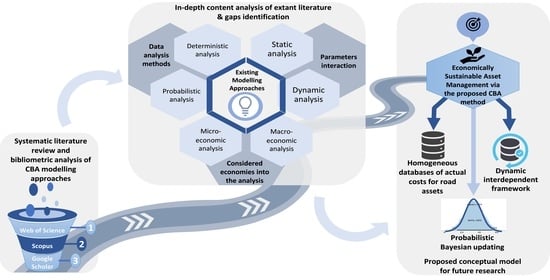Modelling Approaches of Life Cycle Cost–Benefit Analysis of Road Infrastructure: A Critical Review and Future Directions
Abstract
:1. Introduction
2. Systematic Literature Review: Research Protocol and Analysis
3. Results Bibliometric Analysis and Descriptive Statistics
- (a)
- The type of data risk assessment, i.e., deterministic or probabilistic; the former determines single-point estimates for economic indicators such as net present value (NPV) or benefit–cost ratio (BCR). Whereas the latter considers the project’s inherent uncertainties and risks, the outputs are obtained via probability density functions (PDFs), showing a range of possible outcomes likely to occur;
- (b)
- The parameters’ behaviour in terms of interaction between one another, i.e., static or dynamic; the former indicates that the CBAs components are treated as independent of each other, while the latter considers the interdependencies among CBAs costs and benefits:
- (c)
- The encompassed sectors of economy, i.e., microeconomic or macroeconomic; the former indicates that CBA is founded on traditional microeconomic partial equilibrium assuming perfect competition and only user benefits and environmental impacts are considered, while the latter considers a computable general equilibrium (CGE) model where all influenced economies and wider impacts are assumed.
4. In-Depth Content Analysis of Modelling Approaches Used for Performing CBA in Road Infrastructure Projects
4.1. Studies Performing CBA via the Mi-D-S Modelling Category
4.2. Studies Performing CBA via the Ma-D-S Modelling Category
| Type of Paper: Case-Study | |||||
|---|---|---|---|---|---|
| Sources | Research Objective | Applied Modelling Approaches for CBA | Tools of CBA’s Analysis (Key Features) (Applied Software) | Case-Study Application | Cluster Identification |
| Pienaar [40] | The economic variability of existing and new road sections within feasibility studies | Macroeconomic Deterministic Static | Regional economic income analysis (HDM-4 software) | Real-world case-specific road; Namibia | 1 |
| Del Giudice et al. [45] | Reducing the level of uncertainty within feasibility studies of road infrastructure project (RIP) | Microeconomic Probabilistic Static | Monte-Caro simulation (MCS) Probability density functions (PDFs) of uncertain inputs: “Travel time savings”: Normal “investment cost”: Triangular PDFs defined by experts; low level of knowledge (LoK) (@Risk software) | Real-world case-specific road; Italy | 2 |
| Korytárová and Papežíková [46] | Estimating the inaccuracy of economic efficiency ratios in ex-ante road appraisals | Microeconomic Probabilistic Static | MCS Uncertain inputs: “traffic forecast” (Crystal-Ball software) | 27 real-world samples; Czech Republic | 2 |
| Varbuchta et al. [47] | Specifying new risk variables in the transport infrastructure project (TIP) assessment | Microeconomic Probabilistic Static | MCS Uncertain inputs: “external costs”: triangular PDF defined by experts; low LoK | Real-world case-specific road; Czech Republic | 2 |
| Prakash [48] | Capturing crash cost savings in CBAs | Microeconomic Probabilistic Static | MCS Uncertain inputs: “estimated crash number”: Bernoulli PDF defined by experts; low LoK (@Risk software) | Theoretical case | 1 |
| Vagdatli and Petroutsatou [23] | Evaluating non-revenue infrastructure projects for European co-financing eligibility | Microeconomic Probabilistic Static | MCS Uncertain inputs: “annual average daily traffic” (AADT) and “investment cost”; triangular PDF defined by experts; low LoK (@Risk software) | Real-world case-specific road; Greece | 2 |
| Uddin and Mizunoya [28] | Estimating CBA’s key parameters and evaluating economic variability of a proposed RIP | Microeconomic Deterministic Static | (HDM software) | Real-world case-specific highway; Bangladesh | 1 |
| Type of Paper: Methodology | |||||
| Sources | Research objective | Applied modelling approaches for CBA | Proposed method of CBA’s analysis (Key features) (Proposed model’s name) | Scope: -Conceptual -Quantitative examination -Software development (Case-study, if any) | Cluster identification |
| Sullivan et al. [29] | Web-based guide proper application of CBA in transport investment decisions | Microeconomic Deterministic Static | (Cal-B/C Sketch and Cal-B/C Corridor software) | Conceptual | 3 |
| Li and Madanu [49] | Handling certainty, risk and uncertainty in CBAs of highway projects | Microeconomic Probabilistic Dynamic | MCS Uncertain inputs: “construction”, “maintenance”, “traffic growth rates”, “discount rate”; Beta PDF defined by Indiana historical data between 1990–2006; high LoK | Quantitative examination (7380 highway projects; Indiana state) | 2 |
| An and Casper [41] | Estimating B/C ratio for RIP adopting a regional travel demand model and CBA | Macroeconomic Deterministic Static | Regional travel demand model | Quantitative examination (4 real-world samples; Pikes Peak region) | 1 |
| Calthrop et al. [16] | Adjusting CBA for considering markets’ distortions and distributional effects | Macroeconomic Deterministic Static | General equilibrium (GE) model | Quantitative examination (Theoretical case) | 3 |
| Kidokoro [36] | Clarifying the incorporation of the agglomeration effect into conventional CBA | Macroeconomic Deterministic Static | General equilibrium (GE) model | Quantitative examination | 1 |
| Maravas et al.; Maravas and Pantouvakis [50,51] | Modelling inherent uncertainty of TIP into CBA | Microeconomic Probabilistic Static | fuzzy set theory | Quantitative examination (Theoretical case) | 2 |
| Gühnemann et al. [42] | Developing a tool for supporting effective project prioritization in compliance with strategic goals | Macroeconomic Deterministic Static | CBA combined with multi-criteria analysis (MCA); Inputs: conventional benefits; Wider economic impacts (WEIs) and non-monetized impacts | Quantitative examination (A real-world network; Ireland) | 1 |
| DeCorla-Souza et al. [26] | Presenting a three steps CBA frame for Public-Private Partnership (PPP) highway concession proposals evaluation | Microeconomic Deterministic Static | Project delivery Benefit–Cost analysis (PDBCA); (P3-Value 2.0 software) | Software development (Theoretical case) | 3 |
| Salling and Leleur [24,52] | Introducing a new software for assessing TIP using risk-CBA | Microeconomic Probabilistic Static | MCS PDFs of uncertain inputs: “construction costs”: Gamma, “travel time savings”: Normal, “maintenance cost”: Triangular, “accident unit price”: Uniform; PDFs derived from previous studies; medium LoK (CBA-DK software) | Software development | 2 |
| Salling et al. [53] | Presenting a new CBA-based decision support system for assessing uncertainties of TIPs | Macroeconomic Probabilistic Static | MCS Combined with MCA, scenario analysis (SA) (CLG-DSS software) | Software development (Real-world case-specific application) | 2 |
| Salling [54] | Handling construction costs and demand forecasts inaccuracies of TIP in CBA | Microeconomic Probabilistic Static | MCS and Reference Class Forecasting (RCF) PDFs of uncertain inputs: “construction cost”: Erlang; “demand forecast”: Normal; PDFs defined by UNITE database; high LoK (UNITE-DSS model) | Software development (Real-world case-specific fixed-link application; Denmark-Sweden) | 2 |
| Salling and Leleur [55,56] | Examining construction costs and demand forecasts inaccuracies throughout TIP evaluation | Microeconomic Probabilistic Static | MCS and RCF Uncertain inputs: “construction cost”; “demand forecast”; PDFs defined by UNITE database; high LoK (UNITE-DSS model) | Software development (4 real-world samples, each from different types of TIPs) | 2 |
| Manzo and Salling [43] | Clarifying the indirect environmental impacts into the standard CBA results | Macroeconomic Deterministic Static | Life-cycle assessment (LCA) combined with UNITE-DSS model | Quantitative examination (Real-world case-specific fixed-link; Denmark) | 3 |
| Parker and Rommelaere [57] | Integrating the travel time reliability into the CBA | Macroeconomic Probabilistic Static | WEI: travel time reliability MCS; (AutoCASE model) | Software development | 1 |
| Bağdatlı et al. [58] | Dealing with uncertainty in highway CBA via a new approach | Microeconomic Probabilistic Static | Fuzzy cognitive map | Quantitative examination (Real-world case-specific application) | 2 |
| Salling and Banister [59] | Presenting the final version of a new decision support model of risk CBA for TIP assessment | Microeconomic Probabilistic Static | MCS PDFs of uncertain inputs: “traffic forecast”: Pert defined by 183 road projects, “construction costs”: Erlang defined by 167 infrastructure projects; high LoK (CBA-DK software) | Software development | 2 |
| Shiau [60] | Handling uncertainty and incorporating incomplete information into the TIPs evaluation | Macroeconomic Probabilistic Static | Multicriteria decision analysis (MCDA) and Dempster–Shafer Theory | Quantitative examination (Real-world case-specific application; Taiwan) | 2 |
| Nguyen et al. [61] | Capturing the dynamic relationships between CBA components over time | Macroeconomic Deterministic Dynamic | AΒΜ, System Dynamics (SD) and multi-criteria method (MCM) | Conceptual | 1 |
| Rothengatter [18] | Analyzing WEIs measurement and their connection with conventional CBA | Macroeconomic Deterministic Dynamic | Spatial computable general equilibrium (SCGE), Macro and regional economic models, System dynamics, Integrated assessment models, Separated measurement formulas | Conceptual | 1 |
| Laird and Venables [37] | Broadening the scope of conventional CBAs by incorporating three types of WEIs | Macroeconomic Deterministic Static | WEIs: productivity; private investment and land use change; labour market | Conceptual | 1 |
| Nguyen et al. [62] | Presenting an enhanced CBA framework with six functions and four main processes for project evaluation | Microeconomic Probabilistic Static | Enhanced CBA framework | Conceptual | 1 |
| Turró and Penyalver [44] | Assessing the usefulness of major TIPs to future generations | Macroeconomic Deterministic Static | Intergenerational Redistributive Effects Model (IREM) model | Quantitative examination (3 real-world samples; Spain) | 1 |
| Greer and Ksaibati [27] | Developing CBA tools to assist transportation agencies in the estimation of benefits of TIP | Microeconomic Deterministic Static | CBA combined with LOS | Quantitative examination (3 real-world samples) | 3 |
| Hanssen et al. [30] | Investigating to what extent CBAs outcomes differ against the applied model | Microeconomic Deterministic Static | (EFFEKT, EVA and IVAR models) | Quantitative examination (Theoretical case) | 1 |
| Sources | Scope: Theoretical Guidelines Technical Guidelines Software Development | Applied Modelling Approaches for CBA | Producer Surplus | Consumer Surplus (Users Benefits) | Externalities | WEI | Non-Monetized Impacts | Risk— Uncertainty |
|---|---|---|---|---|---|---|---|---|
| World Bank [34] | Technical | Microeconomic Deterministic Static | X | X | * | |||
| OECD [63] | Technical | Macroeconomic Probabilistic Static | X | X | X | X | * | |
| Treasury Board of Canada [64] | Theoretical | Microeconomic Probabilistic Static | * | * | * | * | * | |
| OECD/ITF [39] | Theoretical | Macroeconomic Deterministic Static | * | * | * | * | ||
| OECD/ITF [65] | Theoretical | Microeconomic Probabilistic Static | * | * | * | * | ||
| State of Queensland [66] | Software development (CBA6 software) | Microeconomic Probabilistic Static | X | X | X | X | ||
| Transport Infrastructure Ireland [32] | Technical | Microeconomic Deterministic Static | * | X | * | * | ||
| Minnesota DOT [31] | Technical | Microeconomic Deterministic Static | * | X | ||||
| European Investment Bank [67] | Technical | Macroeconomic Probabilistic Static | X | X | X | * | X | |
| Asian Development Bank [68] | Technical | Microeconomic Probabilistic Static | X | X | * | X | ||
| European Commission [69] | Technical | Microeconomic Probabilistic Static | X | X | X | X | ||
| UK Department for Transport [33] | Theoretical | Microeconomic Deterministic Static | * | * | ||||
| British Columbia [70] | Theoretical | Microeconomic Probabilistic Static | * | * | * | * | ||
| Queensland Treasury [71] | Theoretical | Microeconomic Probabilistic Static | * | * | * | * | ||
| ITF/OECD [38] | Technical | Macroeconomic Deterministic Static | X | |||||
| California DOT [35] | Software development (Cal-B/C software) | Microeconomic Deterministic Static | X | X | X | |||
| United Kingdom HM Treasury [72] | Technical | Macroeconomic Probabilistic Static | * | * | X | X | * | * |
| Commonwealth of Australia [73] | Technical | Macroeconomic Probabilistic Static | * | X | X | * | * | X |
| Transport of New South Wales [74] | Theoretical | Macroeconomic Probabilistic Static | * | * | * | * | * | |
| AIReF [75] | Technical | Macroeconomic Probabilistic Static | X | X | X | X | * |
4.3. Studies Performing CBA via the Ma-P-S Modelling Category
4.4. Studies Performing CBA via the Mi-P-D and Ma-D-D Modelling Category
5. Gaps of CBA Approach and Future Research Directions
5.1. Model’s Probabilistic Imputs Updating
5.2. Dynamic Interdependent Framework
5.3. Homogenous Data Collection and Componentization of Road Assets
5.4. Proposed Conceptual Model for Future Research
6. Conclusions
Author Contributions
Funding

Data Availability Statement
Conflicts of Interest
Appendix A
| WoS: “Topic” field Scopus: “TITLE-ABS-KEY” field |
| “cost–benefit analys *” OR “cost benefit analys *” OR “benefit cost analys *” OR “CBA *” OR “BCA *” OR “Life-cycle cost–benefit analysis” OR “LCCBA” |
| AND |
| road OR highway OR freeway OR transport * infrastructure OR transport * investment * OR infrastructure project * |
| NOT |
| “rail *” OR “airport *” OR “water” OR “aviation *” OR “cycli *” OR “bus *” OR “building *” OR “health *” OR “metro” OR “urban” |
References
- Moschouli, E.; Soecipto, R.M.; Vanelslander, T. Cost Performance of Transport Infrastructure Projects before and after the Global Financial Crisis (GFC): Are Differences Observed in the Conditions of Project Performance? Res. Transp. Econ. 2019, 75, 21–35. [Google Scholar] [CrossRef]
- Yang, D.; Li, J.; Peng, J.; Zhu, J.; Luo, L. Evaluation of Social Responsibility of Major Municipal Road Infrastructure—Case Study of Zhengzhou 107 Auxiliary Road Project. Buildings 2022, 12, 369. [Google Scholar] [CrossRef]
- Browne, D.; Ryan, L. Comparative Analysis of Evaluation Techniques for Transport Policies. Environ. Impact Assess. Rev. 2011, 31, 226–233. [Google Scholar] [CrossRef]
- Donais, F.M.; Abi-Zeid, I.; Waygood, E.; Lavoie, R. A Review of Cost-Benefit Analysis and Multicriteria Decision Analysis from the Perspective of Sustainable Transport in Project Evaluation. EURO J. Decis. Process. 2019, 7, 327–358. [Google Scholar] [CrossRef]
- Mouter, N.; Annema, J.A.; Van Wee, B. Managing the Insolvable Limitations of Cost-Benefit Analysis: Results of an Interview Based Study. Transportation 2015, 42, 277–302. [Google Scholar] [CrossRef]
- Thomopoulos, N.; Grant-Muller, S.; Tight, M.R. Incorporating Equity Considerations in Transport Infrastructure Evaluation: Current Practice and a Proposed Methodology. Eval. Program Plann. 2009, 32, 351–359. [Google Scholar] [CrossRef]
- Beria, P.; Giove, M.; Miele, M. A Comparative Analysis of Assessment Approaches. Six Cases from Europe. Int. J. Transp. Econ. 2012, 39, 185–217. [Google Scholar]
- Van Wee, B.; Banister, D. How to Write a Literature Review Paper? Transp. Rev. 2016, 36, 278–288. [Google Scholar] [CrossRef] [Green Version]
- Linnenluecke, M.K.; Marrone, M.; Singh, A.K. Conducting Systematic Literature Reviews and Bibliometric Analyses. Aust. J. Manag. 2020, 45, 175–194. [Google Scholar] [CrossRef]
- Page, M.J.; Mckenzie, J.E.; Bossuyt, P.M.; Boutron, I.; Hoffmann, T.C.; Mulrow, C.D.; Shamseer, L.; Tetzlaff, J.M.; Akl, E.A.; Brennan, S.E.; et al. The PRISMA 2020 Statement: An Updated Guideline for Reporting Systematic Reviews. BMJ 2021, 372, n71. [Google Scholar] [CrossRef]
- Moher, D.; Liberati, A.; Tetzlaff, J.; Altman, D.G. Preferred Reporting Items for Systematic Reviews and Meta-Analyses: The PRISMA Statement. BMJ 2009, 339, b2535. [Google Scholar] [CrossRef] [PubMed]
- De Vos, J.; El-Geneidy, A. What Is a Good Transport Review Paper? Transp. Rev. 2021, 42, 1–5. [Google Scholar] [CrossRef]
- Raza, Z.; Svanberg, M.; Wiegmans, B. Modal Shift from Road Haulage to Short Sea Shipping: A Systematic Literature Review and Research Directions. Transp. Rev. 2020, 40, 382–406. [Google Scholar] [CrossRef] [Green Version]
- Shukla, A.K.; Janmaijaya, M.; Abraham, A.; Muhuri, P.K. Engineering Applications of Artificial Intelligence: A Bibliometric Analysis of 30 Years (1988–2018). Eng. Appl. Artif. Intell. 2019, 85, 517–532. [Google Scholar] [CrossRef]
- Jan van Eck, N.; Waltman, L. VOSviewer Manual; University Leiden: Leiden, The Netherlands, 2020. [Google Scholar]
- Calthrop, E.; De Borger, B.; Proost, S. Cost-Benefit Analysis of Transport Investments in Distorted Economies. Transp. Res. Part B Methodol. 2010, 44, 850–869. [Google Scholar] [CrossRef] [Green Version]
- Proost, S.; Dunkerley, F.; Van Der Loo, S.; Adler, N.; Broecker, J.; Korzhenevych, A. Do the Selected Trans European Transport Investments Pass the Cost Benefit Test? Transportation 2011, 41, 107–132. [Google Scholar] [CrossRef] [Green Version]
- Rothengatter, W. Wider Economic Impacts of Transport Infrastructure Investments: Relevant or Negligible? Transp. Policy 2017, 59, 124–133. [Google Scholar] [CrossRef]
- Laird, J.J.; Mackie, P.J. Wider Economic Benefits of Transport Schemes in Remote Rural Areas. Res. Transp. Econ. 2014, 47, 92–102. [Google Scholar] [CrossRef]
- Wangsness, P.B.; Rødseth, K.L.; Hansen, W. A Review of Guidelines for Including Wider Economic Impacts in Transport Appraisal. Transp. Rev. 2017, 37, 94–115. [Google Scholar] [CrossRef] [Green Version]
- Koopmans, C.; Oosterhaven, J. SCGE Modelling in Cost-Benefit Analysis: The Dutch Experience. Res. Transp. Econ. 2011, 31, 29–36. [Google Scholar] [CrossRef]
- Abdel-Monem, M.; Alshaer, K.T.; El-Dash, K. Assessing Risk Factors Affecting the Accuracy of Conceptual Cost Estimation in the Middle East. Buildings 2022, 12, 950. [Google Scholar] [CrossRef]
- Vagdatli, T.; Petroutsatou, K. CBA and Probabilistic Risk Analysis Tool for Non-Revenue Generating Infrastructure Projects. The Case of Greece. Case Stud. Transp. Policy 2020, 9, 103–124. [Google Scholar] [CrossRef]
- Salling, K.B.; Leleur, S. Transport Appraisal and Monte Carlo Simulation by Use of the CBA-DK Model. Transp. Policy 2011, 18, 236–245. [Google Scholar] [CrossRef]
- Mackie, P.; Worsley, T.; Eliasson, J. Transport Appraisal Revisited. Res. Transp. Econ. 2014, 47, 3–18. [Google Scholar] [CrossRef]
- DeCorla-Souza, P.; Ham, M.; Timothy, D. Illustration of a Framework for Benefit-Cost Evaluation of Highway Concession Proposals. Transp. Res. Rec. 2016, 2597, 52–59. [Google Scholar] [CrossRef] [Green Version]
- Greer, N.; Ksaibati, K. Development of Benefit Cost Analysis Tools for Evaluating Transportation Research Projects. Transp. Res. Rec. 2019, 2673, 123–135. [Google Scholar] [CrossRef]
- Uddin, M.Z.; Mizunoya, T. An Economic Analysis of the Proposed Dhaka–Chittagong Expressway in Bangladesh with the Viewpoint of GHG Emission Reduction. Asia-Pac. J. Reg. Sci. 2020, 4, 285–314. [Google Scholar] [CrossRef] [Green Version]
- Sullivan, E.; Dahlgren, J.; Weisbrod, G.; Attaran, K. Web-Based Guide to Transportation Benefit-Cost Analysis. J. Transp. Eng. 2008, 134, 282–286. [Google Scholar] [CrossRef]
- Hanssen, T.E.S.; Helo, P.; Solvoll, G.; Westin, J.; Westin, L. Dissimilarities between the National Cost/Benefit Models of Road Projects: Comparing Appraisals in Nordic Countries. Transp. Res. Interdiscip. Perspect. 2020, 8, 100235. [Google Scholar] [CrossRef]
- Minnesota DOT. Benefit-Cost Analysis for Transportation Projects. Available online: https://www.dot.state.mn.us/planning/program/benefitcost.html (accessed on 31 December 2020).
- Transport Infrastructure Ireland Project Appraisal Guidelines—Unit 6.1 Guidance on Conducting CBA; National Roads Authority: Kampala, Uganda, 2011.
- UK Department for Transport. TAG Unit A1.1—Cost Benefit Analysis; Department for Transport: London, UK, 2014.
- World Bank. A Framework for the Economic Evaluation of Transport Projects; World Bank: Washington, DC, USA, 2005. [Google Scholar]
- California DOT. Life-Cycle Benefit/Cost Analysis Model; Department of Transportation: Sacramento, CA, USA, 2017. [Google Scholar]
- Kidokoro, Y. Cost-Benefit Analysis for Transport Projects in an Agglomeration Economy. J. Transp. Econ. Policy 2015, 49, 454–474. [Google Scholar]
- Laird, J.J.; Venables, A.J. Transport Investment and Economic Performance: A Framework for Project Appraisal. Transp. Policy 2017, 56, 1–11. [Google Scholar] [CrossRef]
- ITF/OECD. Incorporating Wider Economic Impacts within Cost-Benefit Appraisal; ITF/OECD: Paris, France, 2016. [Google Scholar]
- OECD/ITF. Cost-Benefit Analysis in Transport: A UK Perspective; OECD/ITF: London, UK, 2010. [Google Scholar]
- Pienaar, W.J. Economic Evaluation of the Proposed Road between Gobabis and Grootfontein, Namibia. S. Afr. J. Econ. 2008, 76, 667–684. [Google Scholar] [CrossRef]
- An, M.; Casper, C. Integration of Travel Demand Model and Benefit-Cost Analysis Method for New Capacity Highway Project. Transp. Res. Board 2010, 2244, 34–40. [Google Scholar] [CrossRef]
- Gühnemann, A.; Laird, J.J.; Pearman, A.D. Combining Cost-Benefit and Multi-Criteria Analysis to Prioritise a National Road Infrastructure Programme. Transp. Policy 2012, 23, 15–24. [Google Scholar] [CrossRef]
- Manzo, S.; Salling, K.B. Integrating Life-Cycle Assessment into Transport Cost-Benefit Analysis. In Proceedings of the 6th Transport Research Arena (TRA), Warsaw, Poland, 18–21 April 2016; Elsevier B.V.: Amsterdam, The Netherlands, 2016; Volume 14, pp. 273–282. [Google Scholar]
- Turró, M.; Penyalver, D. Hunting White Elephants on the Road. A Practical Procedure to Detect Harmful Projects of Transport Infrastructure. Res. Transp. Econ. 2019, 75, 3–20. [Google Scholar] [CrossRef]
- Del Giudice, V.; Passeri, A.; Torrieri, F.; De Paola, P. Risk Analysis within Feasibility Studies: An Application to Cost-Benefit Analysis for the Construction of a New Road. In Proceedings of the 3rd International Conference on Advanced Engineering Materials and Architecture Science (ICAEMAS), Zhuhai, China, 28–30 April 2017; Trans Tech Publications Ltd.: Huhhot, China, 2014; Volume 651–653, pp. 1249–1254. [Google Scholar]
- Korytárová, J.; Papežíková, P. Assessment of Large-Scale Projects Based on CBA. In Proceedings of the Conference on ENTERprise Information Systems (CENTERIS)/International Conference on Project MANagement (ProjMAN)/International Conference on Health and Social Care Information Systems and Technologies (HCist), Vilamoura, Portugal, 7–9 October 2015; Elsevier Science B.V.: Vilamoura, Portugal, 2015; Volume 64, pp. 736–743. Available online: https://www.sciencedirect.com/journal/procedia-computer-science/vol/64/suppl/C (accessed on 3 November 2022).
- Varbuchta, P.; Kovarova, H.; Hromadka, V.; Vitkova, E. Risk Variables in Evaluation of Transport Projects. In Proceedings of the International Conference on Building up Efficient and Sustainable Transport Infrastructure (BESTInfra), Prague, Czech Republic, 21–22 September 2017; IOP Publidhing Ltd.: Prague, Czech Republic, 2017. [Google Scholar]
- Prakash, S. Alternative Approach to Estimating Crash Costs for Cost-Benefit Analysis Using Monte Carlo Simulation. In Proceedings of the 40th Australasian Transport Research Forum (ATRF), Darwin, Australia, 30 October 2018. [Google Scholar]
- Li, Z.; Madanu, S. Highway Project Level Life-Cycle Benefit/Cost Analysis under Certainty, Risk, and Uncertainty: Methodology with Case Study. J. Transp. Eng. 2009, 135, 516–526. [Google Scholar] [CrossRef]
- Maravas, A.; Pantouvakis, J.-P.; Lambropoulos, S. Modeling Uncertainty During Cost Benefit Analysis of Transportation Projects with the Aid of Fuzzy Set Theory. In Proceedings of the Conference on Transport Research Arena, Athens, Greece, 23–26 April 2012; Volume 48, pp. 3661–3670. [Google Scholar]
- Maravas, A.; Pantouvakis, J.P. A New Approach to Studying Net Present Value and the Internal Rate of Return of Engineering Projects under Uncertainty with Three-Dimensional Graphs. Adv. Civ. Eng. 2018, 2018, 6108680. [Google Scholar] [CrossRef] [Green Version]
- Salling, K.B.; Leleur, S. Assessment of Transport Infrastructure Projects by the Use of Monte Carlo Simulation: The CBA-DK Model. In Proceedings of the 2006 IEEE Winter Simulation Conference, Monterey, CA, USA, 3–6 December 2006; pp. 1537–1544. [Google Scholar]
- Salling, K.B.; Leleur, S.; Jensen, A.V. Modelling Decision Support and Uncertainty for Large Transport Infrastructure Projects: The CLG-DSS Model of the Øresund Fixed Link. In Proceedings of the 15th Mini-EURO Conference on Managing Uncertainty in Decision Support Models, Coimbra, Portugal, 22–24 September 2004; Elsevier: Amsterdam, The Netherlands, 2007; Volume 43, pp. 1539–1547. [Google Scholar]
- Salling, K.B. A New Approach to Feasibility Risk Assessment within Transport Infrastructure Appraisal. In Proceedings of the 26th World Congress of the International-Project-Management-Association (IPMA), Seattle, WA, USA, 29–31 October 2012; Elsevier Science B.V.: Crete, Greece, 2013; Volume 74, pp. 468–477. [Google Scholar]
- Salling, K.B.; Leleur, S. Accounting for the Inaccuracies in Demand Forecasts and Construction Cost Estimations in Transport Project Evaluation. Transp. Policy 2015, 38, 8–18. [Google Scholar] [CrossRef]
- Salling, K.B.; Leleur, S. Transport Project Evaluation: Feasibility Risk Assessment and Scenario Forecasting. Transport 2015, 32, 180–191. [Google Scholar] [CrossRef] [Green Version]
- Parker, J.C.; Rommelaere, B. Making Transit Reliability Benefits Accessible to Engineers. In Proceedings of the International Conference on Transportation and Development 2016, Houston, TX, USA, 26–29 June 2016; American Society of Civil Engineers (ASCE): Reston, VA, USA, 2016; pp. 549–561. [Google Scholar]
- Bağdatlı, M.E.C.; Akbıyıklı, R.; Papageorgiou, E.I. A Fuzzy Cognitive Map Approach Applied in Cost–Benefit Analysis for Highway Projects. Int. J. Fuzzy Syst. 2017, 19, 1512–1527. [Google Scholar] [CrossRef]
- Salling, K.B.; Banister, D. Feasibility Risk Assessment of Transport Infrastructure Projects: The CBA-DK Decision Support Model. EJTIR Issue 2010, 10, 103–120. [Google Scholar]
- Shiau, T.A. Evaluating Transport Infrastructure Decisions under Uncertainty. Transp. Plan. Technol. 2014, 37, 525–538. [Google Scholar] [CrossRef]
- Nguyen, T.; Cook, S.; Ireland, V.; Gunawan, I. A Hybrid Approach to Cost-Benefit Analysis in Transport Infrastructure Projects. In Proceedings of the Annual International Conference on System Science and Engineering (ICSSE), Ho Chi Minh City, Vietnam, 21–23 July 2017; pp. 569–574. [Google Scholar]
- Nguyen, T.; Cook, S.; Gunawan, I. A Functional Design of a Cost Benefit Analysis Methodology for Transport Infrastructure Projects. In Proceedings of the 5th IEEE International Conference on Industrial Engineering and Applications (ICIEA), Singapore, 26–28 April 2018; pp. 54–59. [Google Scholar]
- OECD. Cost-Benefit Analysis and the Environment: Recent Developments; Organisation for Economic Co-operation and Development: Paris, France, 2006. [Google Scholar]
- Treasury Board of Canada. Canadian Cost-Benefit Analysis Guide; Treasury Board of Canada Secretariat: Ottawa, ON, Canada, 2007.
- OECD/ITF. The Practice of Cost-Benefit Analysis in the Transport Sector: A Mexican Perspective; OECD: Paris, France, 2010. [Google Scholar]
- State of Queensland. Cost-Benefit Analysis Manual—Road Projects; Department of Transport and Main Roads: Brisbane, Australia, 2011.
- European Investment Bank. The Economic Appraisal of Investment Projects at the EIB; EIB: Luxembourg, 2013. [Google Scholar]
- Asian Development Bank Cost. Benefit Analysis for Development: A Practical Guide; Asian Development Bank Cost: Mandaluyong, Philippines, 2013. [Google Scholar]
- European Commission. Guide to Cost-Benefit Analysis of Investment Projects: Economic Appraisal Tool for Cohesion Policy 2014–2020; European Commission: Brussels, Belgium, 2014. [Google Scholar]
- British Columbia. Benefit-Cost Analysis Guidebook. Guidelines for the Benefit-Cost Analysis of Highway Improvement Projects in British Columbia; Ministry of Transportation and Infrastructure: Victoria, BC, Australia, 2014.
- Queensland Treasury. Project Assessment Framework—Cost-Benefit Analysis; Queensland Treasury: Brisbane City, Australia, 2015.
- United Kingdom HM Treasury. The Green Book—Central Government Guidance on Appraisal and Evaluation; HM Treasury of the United Kingdom: London, UK, 2018.
- Commonwealth of Australia. Australian Transport Assessment and Planning Guidelines—T2 Cost-Benefit Analysis; Commonwealth of Australia: Sydney, Australia, 2018. [Google Scholar]
- Transport of New South Wales. Transport for NSW Cost-Benefit Analysis Guide. 2019. Available online: https://www.transport.nsw.gov.au/projects/project-delivery-requirements/evaluation-and-assurance/transport-for-nsw-cost-benefit (accessed on 31 December 2020).
- de Rus, G.; Campos, J.; Graham, D.; Socorro, M.P.; Valido, J. Methodology for the Cost-Benefit Analysis of Transport Projects and Policies; Independent Authority of Fiscal Responsibility, AIReF: Madrid, Spain, 2020. [Google Scholar]
- Salling, K.B. Assessment of Transport Projects: Risk Analysis and Decision Support; Technical University of Denmark: Bygning, Denmark, 2008. [Google Scholar]
- Flyvbjerg, B.; Holm, M.K.S.; Buhl, S.L. How Common and How Large Are Cost Overruns in Transport Infrastructure Projects? Transp. Rev. 2003, 23, 71–88. [Google Scholar] [CrossRef]
- Nash, D.; Hannah, M. Using Monte-Carlo Simulations and Bayesian Networks to Quantify and Demonstrate the Impact of Fertiliser Best Management Practices. Environ. Model. Softw. 2011, 26, 1079–1088. [Google Scholar] [CrossRef]
- Wu, L.; Ji, W.; AbouRizk, S.M. Bayesian Inference with Markov Chain Monte Carlo–Based Numerical Approach for Input Model Updating. J. Comput. Civ. Eng. 2020, 34, 04019043. [Google Scholar] [CrossRef]
- Leviäkangas, P.; Pargar, F.; Sirvio, K.; Khabbaz Beheshti, B.; Love, P.E.D. Service Value and Componentized Accounting of Infrastructure Assets. J. Infrastruct. Syst. 2019, 25, 04019025. [Google Scholar] [CrossRef] [Green Version]
- Petroutsatou, K.; Maravas, A.; Saramourtsis, A. A Life Cycle Model for Estimating Road Tunnel Cost. Tunn. Undergr. Sp. Technol. 2021, 111, 103858. [Google Scholar] [CrossRef]
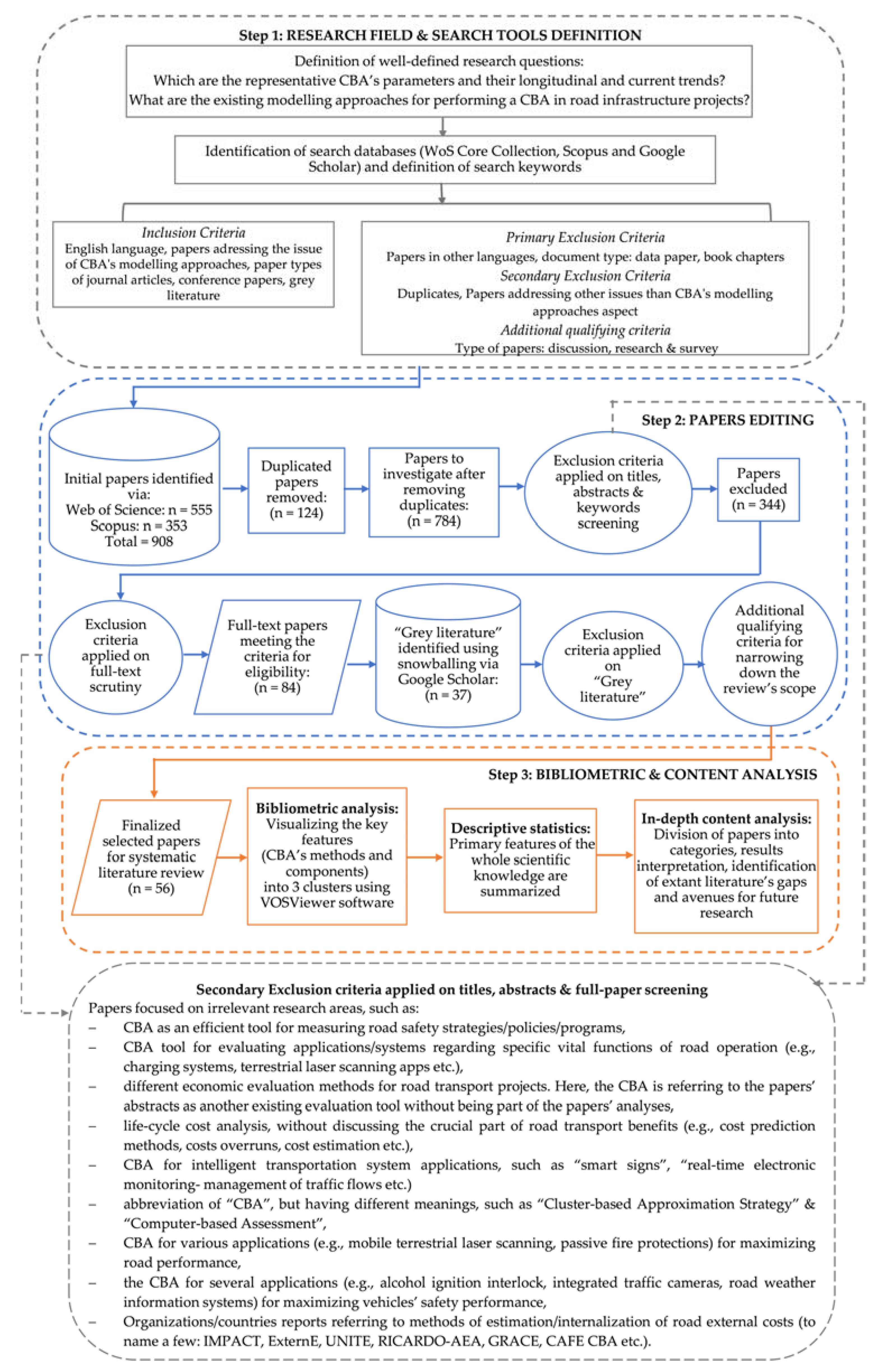
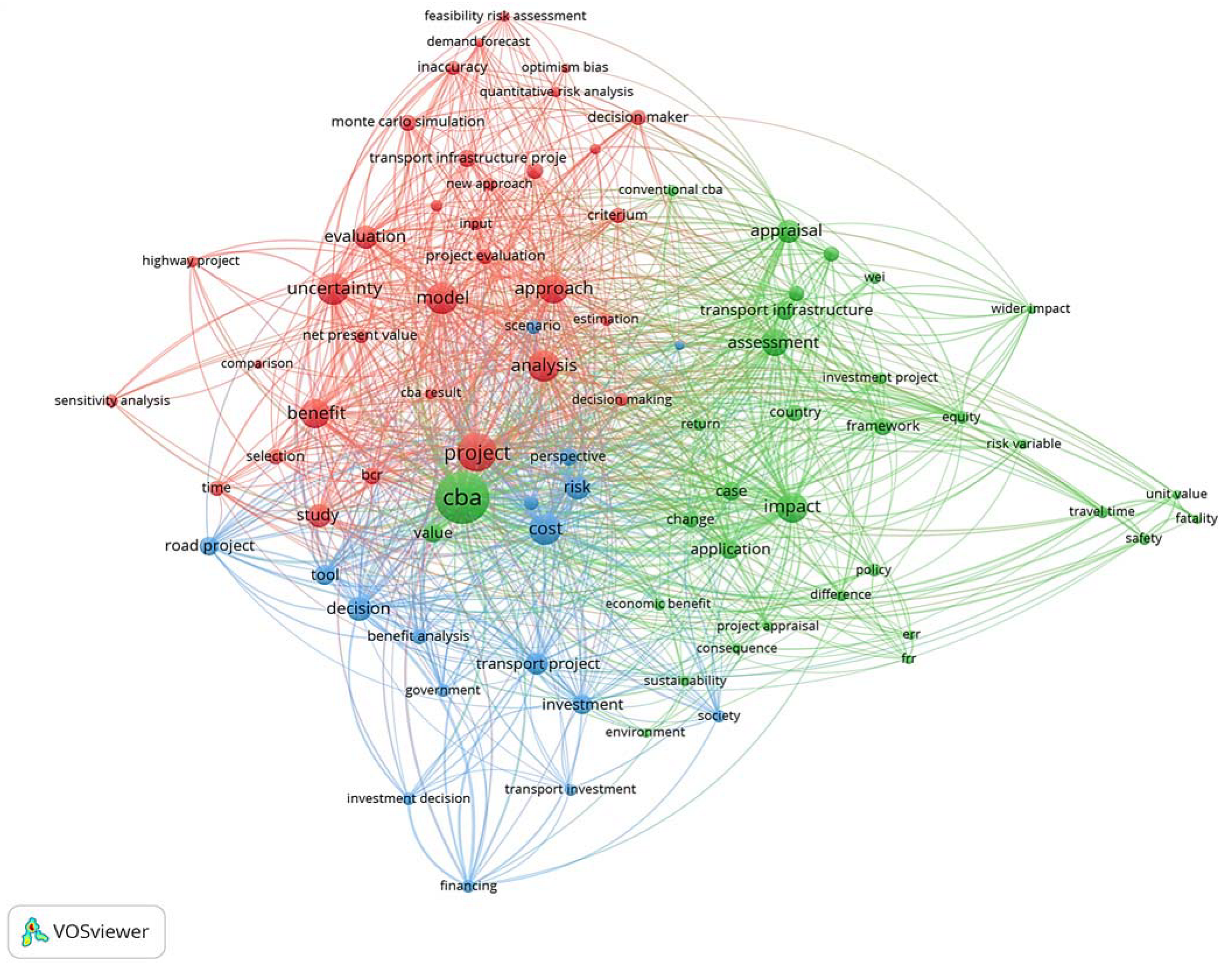
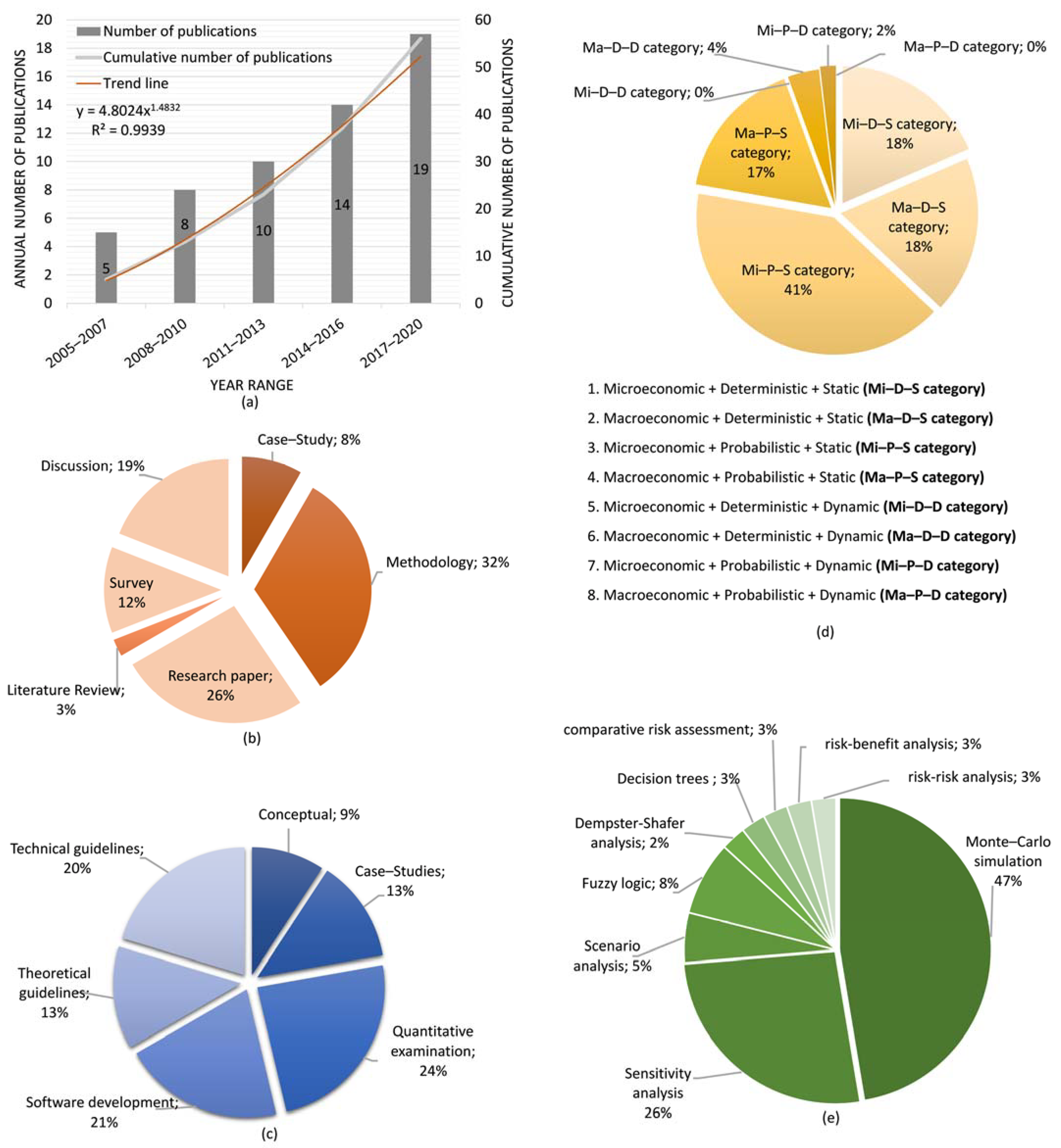
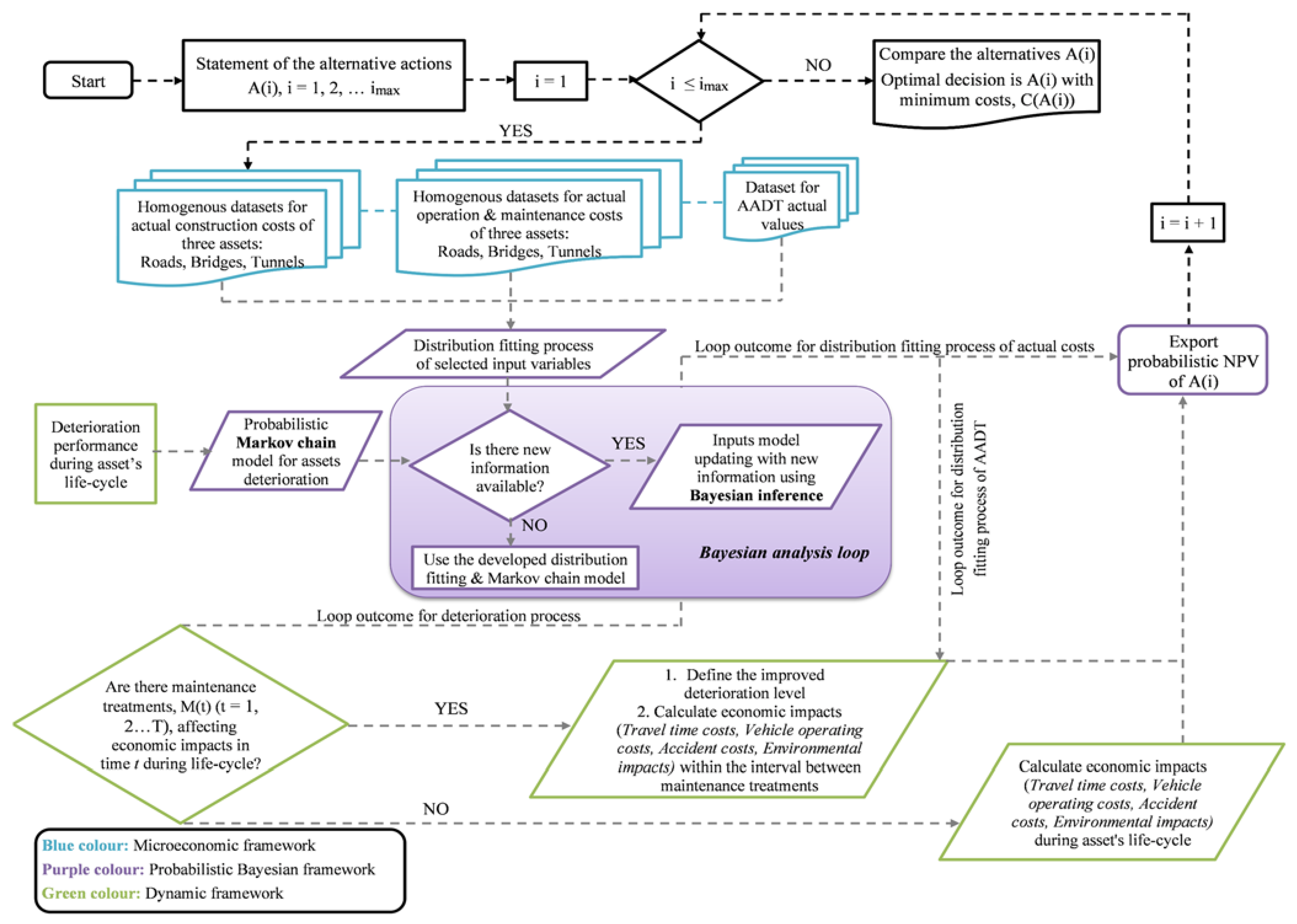
| Modelling Approaches | Main Techniques | Main Characteristics | Key Assumptions |
|---|---|---|---|
| Data analysis methods | |||
| Deterministic | Deterministic mathematical models with fixed values in the variables | Yield single-point output estimates | The randomness or stochasticity of the variables is not taken into account |
| Probabilistic | Monte-Carlo simulation | Probability density functions are assigned to the input variables and outputs are exported within confidence intervals | Incorporates the uncertainty treating the variables as random ones |
| Sensitivity analysis | The impact of one variable on the final outcome is measured by changing the value of the studied variable | All the other variables are remained constant | |
| Scenario analysis | The combined effect of a change in a whole set of assumptions (e.g., “best/worst”, “most likely” scenarios) is analysed | Allows the variation of several variables simultaneously | |
| Parameters interaction | |||
| Static | Traditional CBA techniques | Provides a ‘snapshot’ of CBA system’s response to a specified set of input variables. | The input–output structure is assumed to remain in a steady state |
| Dynamic | System Dynamics | Account for interactions among interrelated variables that drive varying behaviour of the CBA system over time | The behaviour of CBA model’s variables keeps changing over time |
| Considered parameters into the analysis | |||
| Microeconomic | Marshallian consumer’s and producer’s surpluses | User-benefits and external costs are calculated via generalised transportation costs (Rule of Half) | Partial equilibrium perspective where transport network is treated separately from the broader economy |
| Macroeconomic | General computable equilibrium models (e.g., Spatial GCEMs, Land Use Transport Interaction models, regional economic models) | Wider economic impacts are incorporated in traditional CBA | Accounting for changes in external markets assuming imperfect competition |
Disclaimer/Publisher’s Note: The statements, opinions and data contained in all publications are solely those of the individual author(s) and contributor(s) and not of MDPI and/or the editor(s). MDPI and/or the editor(s) disclaim responsibility for any injury to people or property resulting from any ideas, methods, instructions or products referred to in the content. |
© 2022 by the authors. Licensee MDPI, Basel, Switzerland. This article is an open access article distributed under the terms and conditions of the Creative Commons Attribution (CC BY) license (https://creativecommons.org/licenses/by/4.0/).
Share and Cite
Vagdatli, T.; Petroutsatou, K. Modelling Approaches of Life Cycle Cost–Benefit Analysis of Road Infrastructure: A Critical Review and Future Directions. Buildings 2023, 13, 94. https://doi.org/10.3390/buildings13010094
Vagdatli T, Petroutsatou K. Modelling Approaches of Life Cycle Cost–Benefit Analysis of Road Infrastructure: A Critical Review and Future Directions. Buildings. 2023; 13(1):94. https://doi.org/10.3390/buildings13010094
Chicago/Turabian StyleVagdatli, Theodora, and Kleopatra Petroutsatou. 2023. "Modelling Approaches of Life Cycle Cost–Benefit Analysis of Road Infrastructure: A Critical Review and Future Directions" Buildings 13, no. 1: 94. https://doi.org/10.3390/buildings13010094
APA StyleVagdatli, T., & Petroutsatou, K. (2023). Modelling Approaches of Life Cycle Cost–Benefit Analysis of Road Infrastructure: A Critical Review and Future Directions. Buildings, 13(1), 94. https://doi.org/10.3390/buildings13010094






